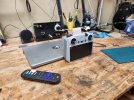I posted this in another thread but that was actually under the Mavic Mod discussion forum. I thought I would put this here:
I just did a quick mod on my RC Controller. I use to be able to do 2300 ft at 200 agl in an urban environment.
After the mod I did 3800 ft. Same time of day, same flight profile, You guys do the math..but that is drastic. Tons of RF interference and obstructions. EDIT: I did 4800 ft after doing the mount.
I am not a DJI fanboy, nor am I not. DJI makes a spec assuming everything is PERFECT. I would assume that is true. Many fly in areas where foliage, buildings, and other obstructions affect things. Just telling you that 15 bucks and 30 minutes make a big difference for me.
DJI makes a spec assuming everything is PERFECT. I would assume that is true. Many fly in areas where foliage, buildings, and other obstructions affect things. Just telling you that 15 bucks and 30 minutes make a big difference for me.
I never removed the original antennas. It would take 5 minutes to plug them back in. I am designing an rf switch that will switch between the two.
The only thing you can see as far as physical changes to the remote are two small (1.5mm) holes to allow the cable to pass through.
I made a quick mount for the antennas with Kydex and it is attached with velcro (good velcro..not cheap stuff..it ain't going anywhere.
My goal is to make an RF switch which will on the back of the antenna mount.
Bottom line: I have done 4 flights with doing this mod. I used the existing patch antennas and the mod. The omni antennas with 8 dbi gain work very well and outperform the stock antennas.


I just did a quick mod on my RC Controller. I use to be able to do 2300 ft at 200 agl in an urban environment.
After the mod I did 3800 ft. Same time of day, same flight profile, You guys do the math..but that is drastic. Tons of RF interference and obstructions. EDIT: I did 4800 ft after doing the mount.
I am not a DJI fanboy, nor am I not.
I never removed the original antennas. It would take 5 minutes to plug them back in. I am designing an rf switch that will switch between the two.
The only thing you can see as far as physical changes to the remote are two small (1.5mm) holes to allow the cable to pass through.
I made a quick mount for the antennas with Kydex and it is attached with velcro (good velcro..not cheap stuff..it ain't going anywhere.
My goal is to make an RF switch which will on the back of the antenna mount.
Bottom line: I have done 4 flights with doing this mod. I used the existing patch antennas and the mod. The omni antennas with 8 dbi gain work very well and outperform the stock antennas.


Last edited:










